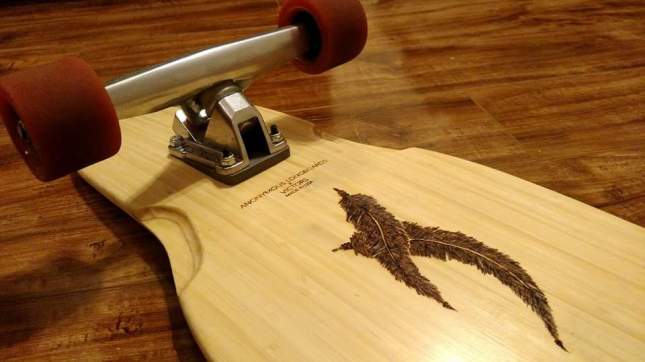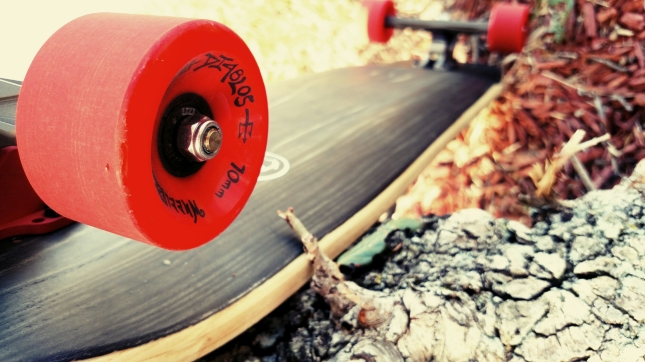The Drang Dancer is quite the impressive deck…it’s the gentle giant of longboarding. Listed on the Drang website as 59×10, it’s impressive dimentions make it quite the spectacle, while it’s design really pursues and encapsulates a peaceful, surfing inspired state of mind. Plus, it’s quite unique in that it’s a very modern take on what could easily considered some of the very first longboards. All skate disciplines have evolved over time, so often as technology improves, trends also change. This means that certain styles may never get to see their gear perfected. Drang is changing that with the Dancer 59″. Not the huge, flat planks wood that your father might have rode, but not the elastic springboards of modern European inspired dancing either. The Drang instead cements itself as a champion of skateboardings homeland, and the surf inspired longboards that first brought boardwalking to the streets. It’s simply the epitome of old school style revitalized by new school innovation.
Freestyle:
Well let’s get right into it! No fucking around this time, dancing and freestyle are what we came to see. So let’s talk about it! The Drang really shows off here with their king of old school style…but let’s start with the cons: Flips and aerial variations are possible, but the weight making for more of a thud than a pop, consistency can vary. Plus, having this giant lug fly at your face is still a little scary even if you have the trick on lock. On the other hand, the leverage from those giant kicks makes manuals, pivots, G-turns and shuvits are all a breeze, and horizontal rotations (I.e. old school kickflips) are easy and not nearly as threatening as other flips. Not to mention how the large stable platform is ready to catch and cradle you any time you feel like you should be the one flying through the air. What this means is that what seems like basic board/body rotations can bee easily combined into more advanced things like shuvit body varials, spinbigs, cross-step ghostride kickflips or any other combination/variation you can think of. Even landing them one foot or cross footed is easy with such a large platform, so incorporating freestyle directly into your dance lines is damn near seamless. Basically your treflip isn’t going to be awkwardly halting your dancing to steal the show…the board is instead designed so that equally impressive tricks can be used in a way that serves your dancing without interrupting your flow.
Dancing:
Speaking of flow. Holy crap guys, this thing is a rolling dance floor. Nearly any step you can imagine is a breeze on its giant EFP. Plus, there’s so much room that everything can be doubled up and combined without having to reset your stance in between. For instance, you can start a cross step and once you get to the last step where your back foot (right, for me) is in front on the other side (left side, for me) instead of having to put your front foot in front of it and then sliding it back towards the rear bolts to start your next step, you can simply treat it like the transitional step of a double Peter pan and place your front foot on its opposite side (left foot, right side…for me) and then do your Peter pan. I know that was probably stupid long and confusing…but long story short: you have room. Plus, that same great landing platform that aided in freestyle makes jump steps, pirouettes and body varials easy to incorporate into your dancing. Plus, while the appeal here is more geared towards steady flow and much more advanced steps…the fast paced simple steps you see a lot now days are possible with the right trucks/bushings. The difference is, if you trip yourself up on this board you don’t eat it so much as you just fall back into a slower more steady step.
Pushing:
It’s a love-hate relationship this board has with distance skating, that’s for sure. With dancing in mind, pushing up to speed was less of a concern than maintaining that speed through various steps and having a large enough platform to perform them on. So basically, it’s pretty heavy to push around…but that and weight keeps its momentum much longer than other boards. With high rebound wheels on a smooth surface you’ll glide for ages on just a few kicks. You will, however, absolutely hate taking this board anywhere you have to push a lot. Uphill, rough roads, busy sidewalks…it all sucks. So if you want to do some dancing at school or even on your way to work then keep the terrain in mind. If the trip there is clear, smooth and flat (or, if you’re insanely lucky, slightly downhill) then it’ll be a breeze and totally worth coasting for blocks on this yacht. On the other hand, any path that keeps you pushing most of the time is a path where you might want to ride a board that’s easier to push.
Freeride:
Believe it or not, this is actually a viable category for this board. Depending on the flex and how you weight your feet, is surprisingly not that hard to get this thing moving sideways. Of coarse, when I say “how you weight your feet” I mean near the bolts…which are pretty damn far from each other. So unless you’re giant yourself, you will have to get creative. Blunts, no-complys, honey butters, one foot stalefish, no-comply blunts, ect… basically anything you can remember that Adam and Adam taught you will still rip in this board. The nice solid curve of the kicks and the subtle wheel flares will keep these tricks from feeling anywhere near as out of place as you would expect them too. Plus, not to sound like a broken record…but like freestyle, freeriding on this board works best when used to compliment a dance line. Though I did purposely mention a few things like blunts and one foot stalefish slides that don’t lend themselves very well to flatground. So that means this board can freeride on a hill, you ask? Well yes…but keep in mind that I’m trying really hard here to make the distinction between the modern DH inspired interpretation of freeride and a much more mellow older style. Think early 2000s videos and you’ll know what I mean.





















